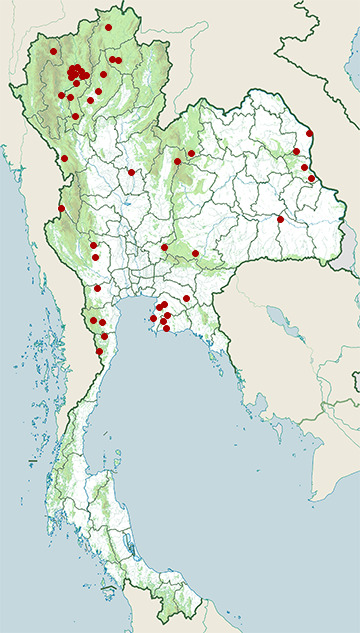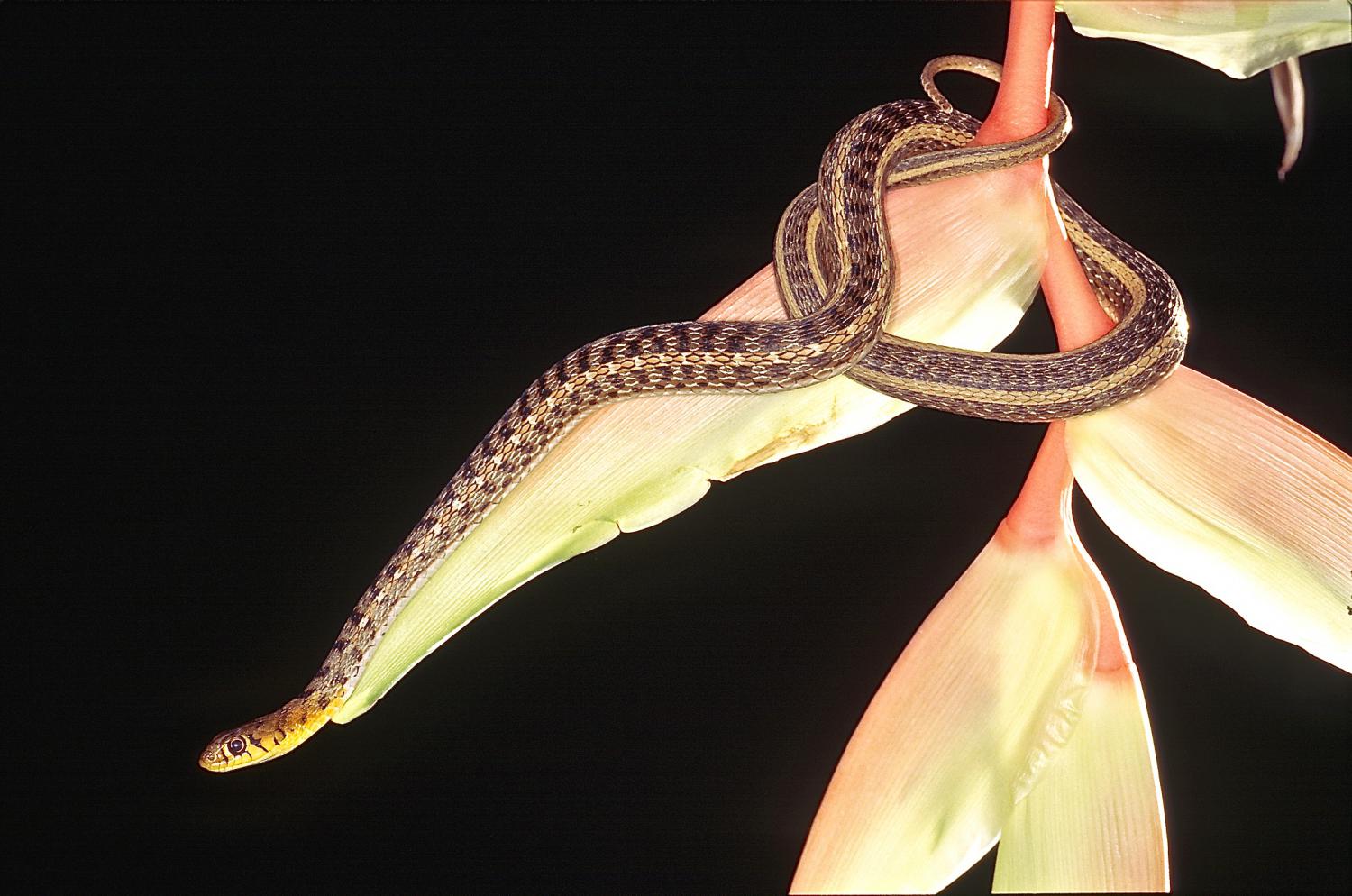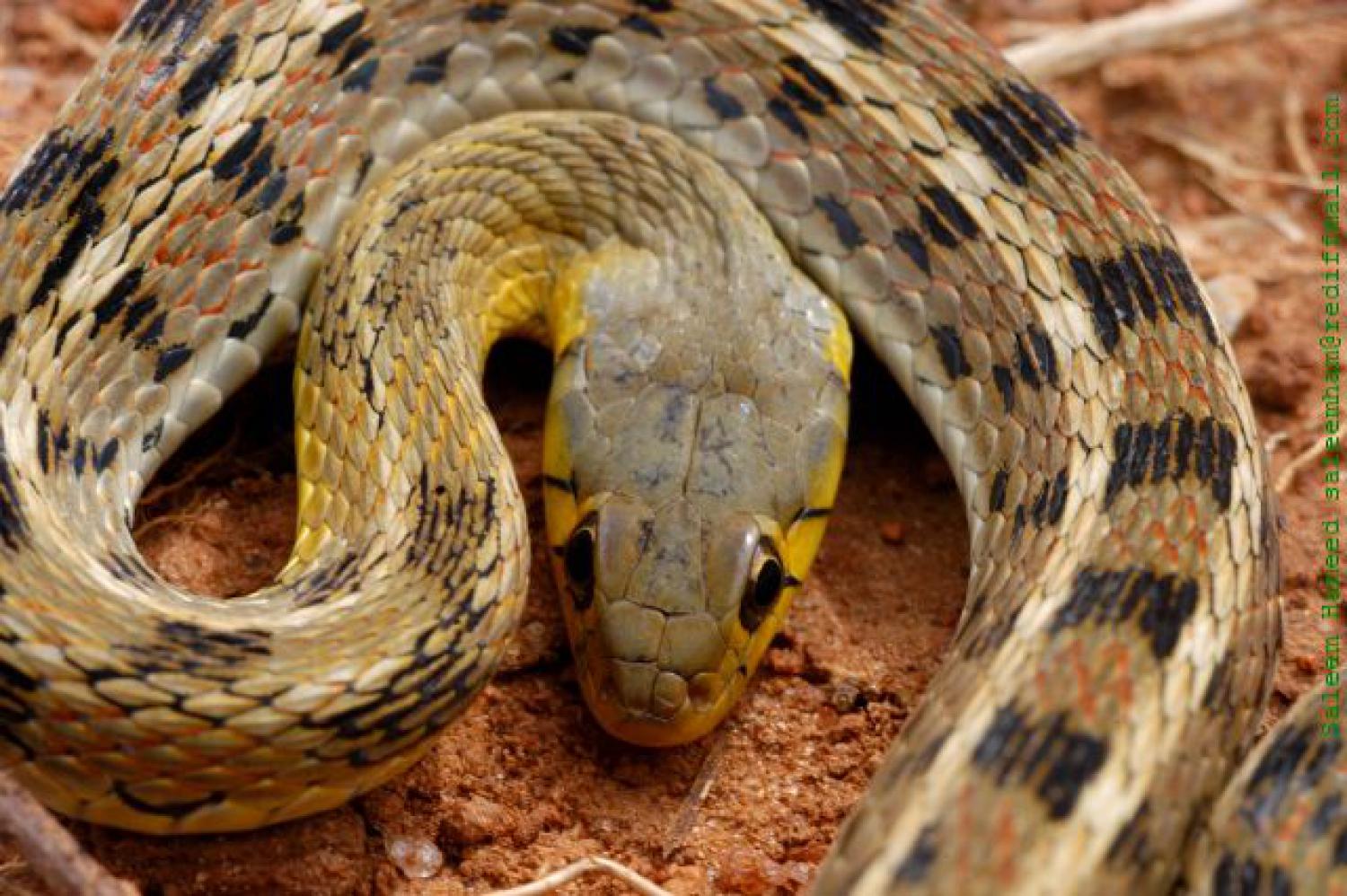Species of Thailand
Buff striped keelback
Amphiesma stolatum
(Carolus Linnaeus, 1758)
In Thai: งูลายสาบดอกหญ้า, ngu lai saap dok ya
The buff striped keelback (Amphiesma stolatum) is a species of nonvenomous colubrid snake found across Asia. It is a typically non-aggressive snake that feeds on frogs and toads. It belongs to the subfamily Natricinae, and is closely related to water snakes and grass snakes. It resembles an Asian version of the American garter snake. It is quite a common snake but is rarely seen.
Anatomy and morphology
A small, slender snake, the buff striped keelback is generally olive-brown to gray in colour. The head and the body are of the same colour.
The body of the buff striped keelback is short, and it has a long slender tail which is almost a quarter of its length. Two yellow stripes along the length and to the sides of the spine are the distinctive feature of this snake. These stripes are diffuse at the head and are especially bright on the second half of its body.
The keelback has irregular blackish crossbars on the body. Near the head the crossbars are prominent, whereas on the second half of the snake they become diffuse.
The sides of the head are yellow, and the head tapers to form a distinctive neck. The nape is red during the breeding season. The chin and throats are white or sometimes orange. There are black vertical markings in front of and behind the large eyes. The eyes have large round pupils with golden flecks on the iris. The forked tongue is black.
The underside is pale cream and has small black spots scattered along both the margins.
It has keeled scales on the dorsal surface of the body.
Morphs
There are two distinct colour varieties – a typical variety, found everywhere, with grayish-blue interscale colour. The second variety, erythrostictus, is common mainly in coastal areas and has bright vermillion interscale colour. The interscale colours become visible only when the snake puffs itself up when agitated.
Identifying characteristics
- The nasal shield does not touch the second supralabial (upper lip shield).
- The rostral touches a total of 6 shields. These are two inter-nasals, two nasals and the first supralabial on each side.
- Presence of single temporal shield.
- Nineteen rows of costals which are strongly keeled except for the outer row which is perfectly smooth.
- Presence of stripes.
- Ventrals 125–161.
- Anal divided.
- Subcaudals 50–85.
Size
The Buff Striped keelback is usually 40 to 50 cm (about 16 to 20 inches) in total length. The maximum length recorded is 90 cm frac=8. Females are consistently longer than the males which only rarely reach 620 mm in length.
Distribution
The buff striped keelback is found throughout South and Southeast Asia. Its range extends from Pakistan (Sindh) to Sri Lanka, India (including the Andaman Islands), Bangladesh, Nepal, Myanmar, Thailand, Laos, Cambodia, Vietnam, Indonesia (Borneo, Sabah), Taiwan and China (Hainan, Hong Kong, Fujian, Jiangxi). It is also found in Bhutan.
In India, the snake is found up to an altitude of 3, 000 m.
Conservation status
The buff striped keelback is common throughout its range, and is not of international conservation concern.
Habitat
This terrestrial, diurnal snake inhabits well-watered lowland plains and hills
Feeding ecology
The primary diet of adult A. stolatum is small amphibians such as frogs and toads, but they are also known to consume fish, earthworms and geckos.
Life history
Keelbacks are oviparous. Mating is thought to take place during the aestivation period. Gravid females have been found from April to August and eggs are laid in underground holes from May to September. The snake lays a clutch of 5 to 10 pure white eggs. Females remain with eggs till they hatch. The young snakes are 13 to 17 cm at birth and eat small frogs, tadpoles, fish, earthworms and insects.
Behavior
The buff striped keelback is diurnal, and although mostly seen on land, it can readily take to water. It has long rear teeth for catching frogs and toads.
The buff striped keelback is nonvenomous and totally harmless. When alarmed, it inflates its body causing the bright interscale colours to be exposed. Sometimes, the snake flattens and narrows its head to form a hood. This behaviour sometimes causes the species to be mistaken by laypersons for a baby cobra.
The snake aestivates during hot weather and appears at the end of summer. It is abundant during the rains. In north India, the striped keelback hibernates 25 to 45 cm (about 10 to 18 inches) under the ground in soil, amongst grass roots.
This article uses material from Wikipedia released under the Creative Commons Attribution-Share-Alike Licence 3.0. Eventual photos shown in this page may or may not be from Wikipedia, please see the license details for photos in photo by-lines.
Scientific classification
- Kingdom
- Animalia
- Phylum
- Chordata
- Subphylum
- Vertebrata
- Class
- Reptilia
- Order
- Squamata
- Suborder
- Serpentes
- Family
- Colubridae
- Genus
- Amphiesma
- Species
- Amphiesma stolatum
Common names
- Chinese: 草腹链蛇
- German:
- Gelbhalswassernatter
- Gestreifte Wassernatter
- Asiatische Streifennatter
- Gelbband-Wassernatter
- English:
- Buff-striped keelback
- White-striped keelback
- Thai: งูลายสาบดอกหญ้า, ngu lai saap dok ya
Conservation status

Least Concern (IUCN 3.1)
Photos
Please help us review our species pages if wrong photos are used or any other details in the page is wrong. We can be reached via our contact us page.
Range Map

- Ban Bueng District, Chonburi
- Ban Hong District, Lamphun
- Bang Lamung District, Chonburi
- Bo Phloi District, Kanchanaburi
- Bueng Bun District, Sisaket
- Chae Hom District, Lampang
- Chom Bueng District, Ratchaburi
- Chom Thong District, Chiang Mai
- Doi Saket District, Chiang Mai
- Doi Suthep - Pui National Park
- Dok Khamtai District, Phayao
- Don Tan District, Mukdahan
- Hang Dong District, Chiang Mai
- Hua Hin District, Prachuap Khiri Khan
- Kaeng Krachan District, Phetchaburi
- Kaeng Krachan National Park
- Ko Kha District, Lampang
- Kui Buri National Park
- Li District, Lamphun
- Mae On District, Chiang Mai
- Mae Rim District, Chiang Mai
- Mae Sot District, Tak
- Muak Lek District, Saraburi
- Mueang Chiang Mai District, Chiang Mai
- Mueang Chiang Rai District, Chiang Rai
- Mueang Lampang District, Lampang
- Mueang Lamphun District, Lamphun
- Mueang Mukdahan District, Mukdahan
- Mueang Nakhon Phanom District, Nakhon Phanom
- Mueang Phayao District, Phayao
- Mueang Phichit District, Phichit
- Mueang Rayong District, Rayong
- Na Kae District, Nakhon Phanom
- Nam Nao National Park
- Nikhom Phatthana District, Rayong
- Nong Prue District, Kanchanaburi
- Pai District, Mae Hong Son
- Phu Kradueng District, Loei
- Pluak Daeng District, Rayong
- Sakaerat Environmental Research Station
- San Kamphaeng District, Chiang Mai
- San Sai District, Chiang Mai
- Si Racha District, Chonburi
- Tha Takiap District, Chachoengsao
- Thung Yai Naresuan Wildlife Sanctuary



